Archaeologists discovered the oldest pyramid in the world in Indonesia: Gunung Padang
[ad_1]

A colossal megalithic structure in West Java has captured the imagination of scientists
New evidence suggests that the oldest known pyramid in the world may not be one of the Egyptian structures or the pyramids of the Indians of Latin America, but the Indonesian Gunung Padang.
Gunung Padang, a colossal megalithic structure located in the lush landscape of West Java in Indonesia, may be the oldest pyramid in the world. Recent research suggests that this ancient site may predate the famous Egyptian pyramids and even predate the stone wonders of Gobekli Tepe in Turkey.
How tells Arkeonews, a team of archaeologists, geophysicists, exploration geologists and paleontologists associated with several institutions in Indonesia, has discovered evidence that Gunung Padang is the oldest known pyramid in the world.
The team describes their multi-year study of the cultural heritage site in a paper recently published in the interdisciplinary archaeological journal Archaeological Prospection.
Gunung Padang, also known as the “mountain of enlightenment,” is located on top of an extinct volcano and is considered a sacred place by locals. In 1998, Gunung Padang was declared a National Cultural Heritage Site.
A new study by geologist Danny Hilman Natawidjaja and his team from the Indonesian National Agency for Research and Innovation suggests that Gunung Padang dates back to the last ice age, approximately 25,000-14,000 years ago.
According to the team, the pyramid’s oldest structure likely “emerged as a natural lava mound before being sculpted and then architecturally enveloped.” Thus, Gunung Padang is at least 16 thousand years old.
According to the study, the pyramid was completed between 2000 and 1100 BC.
More specifically, the researchers found evidence of several efforts that, when combined over time, led to the completed structure. The first was lava sculpture, in which builders carved figures on top of a small, dead volcano. Another group added a layer of bricks and stone columns several thousand years later, sometime between 7900 and 6100 BC. Another group later added a layer of dirt to part of the hill, covering up some of the earlier work. Then, between 2000 and 1100 BC, additional topsoil, rock terraces and other features were added.
The study challenges conventional wisdom by highlighting the advanced capabilities of masonry demonstrated by the builders of Gunung Padang. Contrary to expectations based on traditional hunter-gatherer cultures, the study shows the existence of advanced construction techniques during the last Ice Age.
The research team conducted a long-term scientific study of the structure for this new study. They studied the structure using seismic tomography, electrical resistivity tomography and ground penetrating radar from 2011 to 2015. They also drilled into the hill and collected core samples, allowing them to use radiocarbon dating techniques to determine the age of the hill’s layers.
The research team also found some evidence that there may be some hollow parts inside the structure, suggesting possible hidden cameras. They plan to drill down into them and then lower the camera to see what might be in those areas.
“Gunung Padang provides remarkable evidence that it is potentially the oldest pyramid in the world,” the researchers said in the article.
[ad_2]
Source link








